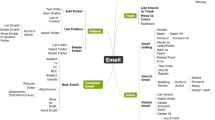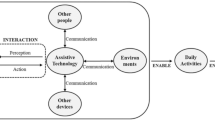Abstract
At the clinical department of Dermatology at the Medical University Hospital in Graz, approximately 30 outpatients consult the pigmented lesion clinic each day. During the visit, the patients are asked to complete a questionnaire, which is necessary, both for the clinical information system and for a scientific database for research in skin cancer. However, motorically and visually handicapped people usually have problems in completing paper based questionnaires. Consequently, a system was built, using a mobile touch computer with a specially designed interface, in order to assist these people and to allow full mobility within the clinical department, as well as the possibility of completing questionnaires, for example: during a cancer survey even in the open-air swimming resort. The system was developed by applying a User Centered Design including four levels: paper mock-up studies, low-fi prototypes, hi-fi prototypes and the system in real life. Scientifically this work provided insights into the technical possibilities, Human-Computer Interaction and Usability Engineering, user acceptance in the clinical field and the possible optimization potential of clinical workflows.
Access this chapter
Tax calculation will be finalised at checkout
Purchases are for personal use only
Preview
Unable to display preview. Download preview PDF.
Similar content being viewed by others
References
Stephanidis, C. (ed.): User Interfaces for All: Concepts, Methods and Tools. Lawrence Erlbaum, Mahwah (2001)
Myers, B., et al.: Strategic directions in human-computer interaction. ACM Computing Surveys (CSUR) 28(4), 794–809 (1996)
Holzinger, A., Errath, M.: Designing Web-Applications for Mobile Computers: Experiences with Applications to Medicine. In: Stary, C., Stephanidis, C. (eds.) UI4ALL 2004. LNCS, vol. 3196, pp. 262–267. Springer, Heidelberg (2004)
Bludau, H.-B., Koop, A.: Mobile Computing in Medicine. In: Second Conference on Mobile Computing in Medicine, Lecture Notes of Informatics, Heidelberg, GI (2002)
Hameed, K.: The application of mobile computing and technology to health care services. Telematics and Informatics 20(2), 99–106 (2003)
Norman, D.A., Draper, S.: User Centered System Design. Erlbaum, Hillsdale (1986)
Holzinger, A.: User-Centered Interface Design for disabled and elderly people: First experiences with designing a patient communication system (PACOSY). In: Miesenberger, K., Klaus, J., Zagler, W. (eds.) ICCHP 2002. LNCS, vol. 2398, pp. 34–41. Springer, Heidelberg (2002)
Holzinger, A.: Experiences with User Centered Development (UCD) for the Front End of the Virtual Medical Campus Graz. In: Jacko, J.A., Stephanidis, C. (eds.) Human-Computer Interaction, Theory and Practice, pp. 123–127. Lawrence Erlbaum, Mahwah (2003)
Holzinger, A.: Application of Rapid Prototyping to the User Interface Development for a Virtual Medical Campus. IEEE Software 21(1), 92–99 (2004)
Stephanidis, C., Savidis, A.: Universal Access in the Information Society: Methods, Tools and Interaction Technologies. Universal Access in the Information Society 1(1), 40–55 (2001)
Gell, G., et al.: HIS purchase projects in public hospitals of Styria, Austria. International Journal of Medical Informatics 58-59, 147–155 (2000)
Holzinger, A.: Finger Instead of Mouse: Touch Screens as a means of enhancing Universal Access. In: Carbonell, N., Stephanidis, C. (eds.) UI4ALL 2002. LNCS, vol. 2615, pp. 387–397. Springer, Heidelberg (2003)
Wilson, J., Rosenberg, D.: Rapid Prototyping for User Interface Design. In: Helander, M. (ed.) Human-Computer Interaction, pp. 859–875. North Holland, Amsterdam (1988)
Rettig, M.: Prototyping for tiny fingers. Communications of the ACM 37(4), 21–27 (1994)
Virzi, R.A., Sokolov, J.L., Karis, D.: Usability problem identification using both low- and high-fidelity prototypes. In: CHI Conference on Human Factors in Computing Systems, pp. 236–243 (1996)
Weiss, S.: Handheld Usability, p. 292. John Wiley and Sons, New York (2002)
Karampelas, P., Akoumianakis, D., Stephanidis, C.: User Interface Design for PDAs: Lessons and Experiences with the WARD-IN-HAND prototype. In: Carbonell, N., Stephanidis, C. (eds.) UI4ALL 2002. LNCS, vol. 2615, pp. 474–485. Springer, Heidelberg (2003)
Buchanan, G., et al.: Improving mobile internet usability. In: International World Wide Web Conference, Hong Kong (2001)
Holzinger, A.: Multimedia Basics. In: Design. Developmental Fundamentals of multimedial Information Systems, vol. 3. Laxmi Publications, New Delhi (2002)
Holzinger, A.: Usability Engineering for Software Developers. Communications of the ACM 48(1), 71–74 (2005)
Beaudouin-Lafon, M., Mackay, W.: Prototyping Tools and Techniques. In: Jacko, J.A., Sears, A. (eds.) The Human-Computer Interaction Handbook: Fundamentals, Evolving Technologies and Emerging Applications, Erlbaum, Mahwah (2003)
Chittaro, L. (ed.): Mobile HCI 2003. LNCS, vol. 2795, p. 2003. Springer, Heidelberg (2003)
Jessup, L.M., Robey, D.: Issues and challenges in mobile computing: The relevance of social issues in ubiquitous computing environments 45(12), 88–91 (2002)
Brewster, S.: Overcoming the Lack of Screen Space on Mobile Computers. Personal and Ubiquitous Computing 6(3), 188–205 (2002)
Author information
Authors and Affiliations
Editor information
Editors and Affiliations
Rights and permissions
Copyright information
© 2006 Springer-Verlag Berlin Heidelberg
About this paper
Cite this paper
Holzinger, A., Sammer, P., Hofmann-Wellenhof, R. (2006). Mobile Computing in Medicine: Designing Mobile Questionnaires for Elderly and Partially Sighted People. In: Miesenberger, K., Klaus, J., Zagler, W.L., Karshmer, A.I. (eds) Computers Helping People with Special Needs. ICCHP 2006. Lecture Notes in Computer Science, vol 4061. Springer, Berlin, Heidelberg. https://doi.org/10.1007/11788713_107
Download citation
DOI: https://doi.org/10.1007/11788713_107
Publisher Name: Springer, Berlin, Heidelberg
Print ISBN: 978-3-540-36020-9
Online ISBN: 978-3-540-36021-6
eBook Packages: Computer ScienceComputer Science (R0)




